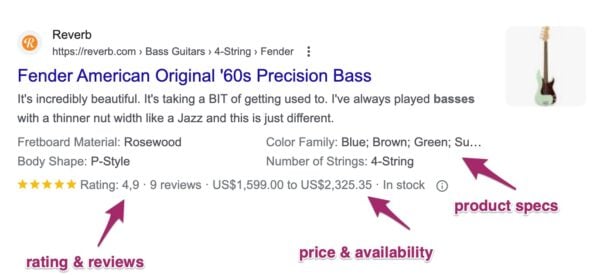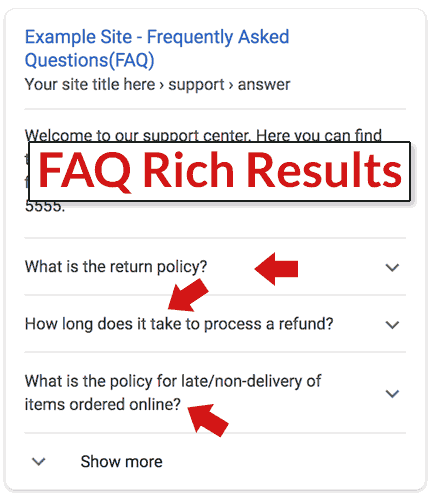Last Updated on September 24, 2025
What is Schema (Structured Data)?
We often talk about helping Google understand our content. Schema markup is one of the best ways to do this.
Think of a website’s content as a recipe. A search engine can read the text and see “flour,” “sugar,” and “butter,” but it doesn’t know what each ingredient is or how they relate to each other. Structured data is like adding a nutrition label and clear instructions to the recipe. It uses a specific format to explicitly tell search engines what your content is about—whether it’s an article, a product, a local business, or an event—and to highlight key details like ratings, prices, or locations.
One of the main benefits to putting schema in place is that they make it more likely that you’ll qualify for “rich results” (or “rich snippets”). Rich results are kind of like Google Ads assets (extensions) for organic results. They can display your content in more visually appealing and informative ways. Some examples are:
- Organic sitelinks
- Star ratings for products/reviews
- Event info (time, location)
- FAQs
Similar to Google Ads assets, rich results can significantly improve your click-through rate (CTR).
In addition to being helpful for SEO, schema implementation is commonly cited as one of the most essential parts of AI optimization.
Most Useful Schema Types for Digital Marketing
There are tons of schema types, but a few are particularly valuable for our purposes: Article, Product, Review, FAQ, LocalBusiness, and Organization.
This is a foundational schema for any website. It is set at the website-level (not specific page-types) and provides information about a company, such as its name, official logo, contact information, and social media profiles.
Structured Data Example (not related to above picture):
<script type=”application/ld+json”>
{
“@context”: “[https://schema.org](https://schema.org)”,
“@type”: “Organization”,
“name”: “Your Agency Name”,
“url”: “[https://www.youragencywebsite.com](https://www.youragencywebsite.com)”,
“logo”: “[https://www.youragencywebsite.com/images/logo.png](https://www.youragencywebsite.com/images/logo.png)”,
“sameAs”: [
“[https://www.facebook.com/youragency](https://www.facebook.com/youragency)”,
“[https://twitter.com/youragency](https://twitter.com/youragency)”
]
}
</script>
Essential for any client with a physical location. This schema provides details like the address, phone number, opening hours, and a map location, helping the business appear in local search results and the Google Knowledge Panel.
Google Knowledge Panel:

Structured Data Example (not related to above picture):
{
“@context”: “https://schema.org”,
“@type”: “LocalBusiness”,
“name”: “Acme Marketing Agency”,
“image”: “https://www.your-agency.com/images/logo.png”,
“address”: {
“@type”: “PostalAddress”,
“streetAddress”: “123 Main Street”,
“addressLocality”: “Anytown”,
“addressRegion”: “CA”,
“postalCode”: “90210”,
“addressCountry”: “US”
},
“geo”: {
“@type”: “GeoCoordinates”,
“latitude”: “34.0522”,
“longitude”: “-118.2437”
},
“url”: “https://www.your-agency.com”,
“telephone”: “+15551234567”,
“openingHoursSpecification”: [{
“@type”: “OpeningHoursSpecification”,
“dayOfWeek”: [
“Monday”,
“Tuesday”,
“Wednesday”,
“Thursday”,
“Friday”
],
“opens”: “09:00”,
“closes”: “17:00”
}],
“sameAs”: [
“https://www.facebook.com/your-agency”,
“https://www.linkedin.com/company/your-agency”
]
}
Use on blogs, news sites, and any other content-driven website. It helps search engines understand the title, author, publish date, and main content of an article, which can lead to better visibility and placement in Google News or Top Stories. For Sebo, this will be one of the most commonly used Schemas (since most of our clients have blogs).
Rich result example:

Structured data example (not related to above picture):
{
“@context”: “https://schema.org”,
“@type”: “Article”,
“headline”: Strengthen Your Brand’s Authority Through Off-Page SEO”,
“image”: [
“https://sebomarketing.com/wp-content/uploads/2025/02/Google-Search-Results-1500×750.jpg”
],
“datePublished”: “2025-02-05T09:00:00+08:00”,
“dateModified”: “2025-02-05T10:30:00+08:00”,
“author”: {
“@type”: “Person”,
“name”: “Sebo Marketing”
},
“publisher”: {
“@type”: “Organization”,
“name”: “Sebo Marketing”,
“logo”: {
“@type”: “ImageObject”,
“url”: “https://secure.gravatar.com/avatar/3d36d6919383408c1b01dfe509a5a3ca59a1f5d58e45fc468fab6b28905c6344?s=80&d=https%3A%2F%2Fsebomarketing.com%2Fwp-content%2Fthemes%2Fdt-the7%2Fimages%2Fmask.png&r=g”
}
},
“description”: ” “
}
Crucial for e-commerce clients. This markup highlights key product information like price, availability, and customer ratings, which can display as star ratings and other rich results directly in Google Search.
Rich results example:

Structured data example (not related to above picture):
{
“@context”: “https://schema.org”,
“@type”: “Product”,
“name”: “Madison Basic TV Lift Cabinet”,
“description”: “The Madison Basic TV Lift Cabinet is a stunning transitional style that adds beauty to a home while also serving as a high-tech TV lift cabinet to hide the television. It is designed to be \”Furniture First™,\” combining traditional design with modern style to elevate the feel of any room. It holds a maximum TV size of 55 inches.”,
“sku”: “madison-basic-tv-lift-cabinet”,
“offers”: {
“@type”: “Offer”,
“priceCurrency”: “USD”,
“price”: “3219.00”,
“itemCondition”: “https://schema.org/NewCondition”,
“availability”: “https://schema.org/InStock”
}
}
Should be used on any FAQ page. This schema can enable Google to display the Q&A content as a collapsible rich result on the SERP.
Rich result example:

Structured data example (not related to above image):
{
“@context”: “https://schema.org”,
“@type”: “FAQPage”,
“mainEntity”: [{
“@type”: “Question”,
“name”: “What is the average production time for a custom TV lift cabinet?”,
“acceptedAnswer”: {
“@type”: “Answer”,
“text”: “The production time for our custom TV lift cabinets is typically between 5-6 weeks, depending on the complexity of the design and current demand. We will provide a more precise timeline upon order confirmation.”
}
}, {
“@type”: “Question”,
“name”: “Do you offer international shipping?”,
“acceptedAnswer”: {
“@type”: “Answer”,
“text”: “Yes, we ship to many international locations. Please contact our customer service team to get a specific quote for your region and to confirm shipping availability.”
}
}, {
“@type”: “Question”,
“name”: “What is your return policy?”,
“acceptedAnswer”: {
“@type”: “Answer”,
“text”: “We want you to be completely satisfied with your purchase. We offer a 30-day return policy for unused items in their original packaging. For more details, please review our full return policy on our website.”
}
}]
}
This is used to mark up reviews and ratings for a product, business, or service.
Example:

Structured Data Example (not related to above picture):
{
“@context”: “https://schema.org”,
“@type”: “Product”,
“name”: “Luxury TV Lift Cabinet”,
“aggregateRating”: {
“@type”: “AggregateRating”,
“ratingValue”: “4.8”,
“reviewCount”: “25”
},
“review”: [{
“@type”: “Review”,
“reviewRating”: {
“@type”: “Rating”,
“ratingValue”: “5”
},
“name”: “Stunning and Functional”,
“author”: {
“@type”: “Person”,
“name”: “Jane Doe”
},
“datePublished”: “2023-08-15”,
“reviewBody”: “This TV lift cabinet is even more beautiful in person! It’s incredibly well-made and the lift mechanism is smooth and quiet. It’s a fantastic piece of furniture.”
}, {
“@type”: “Review”,
“reviewRating”: {
“@type”: “Rating”,
“ratingValue”: “4”,
“bestRating”: “5”
},
“name”: “Great Product, A Little Slow on Delivery”,
“author”: {
“@type”: “Person”,
“name”: “John Smith”
},
“datePublished”: “2023-08-10”,
“reviewBody”: “The cabinet itself is perfect, but it took a little longer to ship than expected. The quality is worth the wait, though.”
}]
}
How to Implement Schema Markup
For most modern websites, there are two primary ways to implement schema. How you implement schema will vary based on your situation:
Schema Pro: We have an unlimited-use license for a plugin called “Schema Pro”. This plugin should cover all of our schema needs for WordPress sites. Here are directions for getting it onto a client’s site:
- Navigate to https://wpschema.com/.
- Log in as agency@sebomarketing.com.
- Put in the confirmation code (sent to the agency@sebomarketing.com email).
- Click the “download” icon next to “SCHEMA PRO”.
- Log into the backend of the client’s site.
- Click “Plugins” -> “Add Plugin” -> “Upload Plugin”
- Drag the Schema Pro file you downloaded onto the “Choose File” box
- Click “Activate Plugin”
It is possible to set all of this up manually using GTM, but it won’t be dynamic (in other words, you’ll need to put a raw HTML tag on each page with the information pre-filled). This isn’t too bad if you only need a one-off (for example, if you have 1 FAQ page and just need to set up FAQPage scheme one time), but is definitely not ideal in any other case.
Follow this video guide: https://www.youtube.com/watch?v=lLNo99bphZM
How to Make Sure Your Schema Is Working
Making sure your schema is working is a pretty simple process. All you need to do is:
- Go to the Google Rich Results tool.
- Enter the URL you are testing.
- Verify that your desired rich results are showing up.
For example, in the picture on the right, we tested a Wildwood TV Lift Furniture product page. We are hoping to AT LEAST see “product” schema in place. It looks like they have a few more things going on in addition to “product” schema, but they do have the correct schema in place.
If you don’t see the schema that you are expecting, you may need to troubleshoot further.







